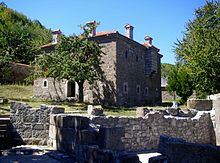Boletin
|
Boletin / Boletini 1 Boljetin / Бољетин 2 |
||||
|
||||
| Basic data | ||||
|---|---|---|---|---|
| State : |
|
|||
| District : | Mitrovica | |||
| Municipality : | Zvečan | |||
| Coordinates : | 42 ° 56 ' N , 20 ° 51' E | |||
| Height : | 697 m above sea level A. | |||
| Residents : | 43 (2009) | |||
| Telephone code : | +383 (0) 28 | |||
| License plate : | 02 | |||
|
1 Albanian (indefinite / definite form) , 2 Serbian (Latin / Cyrillic spelling) 3 Kosovo's independence is controversial. Serbia continues to regard the country as a Serbian province. |
||||
Boletin ( Albanian also Boletini , Serbian Бољетин Boljetin ) is a village in the municipality of Zvečan in Kosovo , about five kilometers northeast of Mitrovica .
Population and politics
Along with Lipa and Zhazha, Boletin is one of the three villages that are located in the Zvečan municipality , which is mainly inhabited by Serbs and where exclusively Kosovar Albanians live. In total, there are an estimated 350 people, who represent a minority of 2.1 percent of the community population (as of 2006).
Until 2002, the residents of Boletin, Lipa and Zhazha boycotted the Zvečan municipal administration. In December 2002, however, they elected representatives from among their ranks at a public meeting who, under the leadership of the UN community administrator, took part in an arbitration and community committee. The community committee has met regularly since then, except in 2004, when the pogrom-like March riots against the Serbian and non-Albanian population by extremist Albanians in Kosovo broke out.
history
In the 12th century the region around Boletin belonged to the Serbian dominion. After Stefan Dragutin was deposed as king by the Serbian Imperial Assembly, his brother Milutin was enthroned as his successor in 1282, to whose kingdom the entire region around Boletin belonged until his death in 1321. The body of the Serbian king was buried in the Banjska monastery, which is in the immediate vicinity. He was succeeded by his son Uroš III. Dečanski , who as a child was under the care of Kara Nogai Khan , the Mongolian leader of the Golden Horde , and from then on ruled the region. When the Ottomans invaded Serbia in the 14th century , the Banjska Monastery was largely destroyed and a military camp and a small mosque were built on the site . The monastery could only be partially restored in the 21st century.
Before the destruction, the body of Uroš II Milutin could be saved and reburied, first to Trepča, which is located in today's Mitrovica , then to Bulgaria in 1460 , where it was kept until 2007, when it was returned to Serbia as a sign of solidarity has been. Today he rests again in the Banjska Monastery. After the death of the Serbian king Uroš III. Dečanski, ruled among others the Serbian aristocratic families Musić and Vojinović in the region, which was to belong to the Serbian Empire until the middle of the 15th century . When the Ottomans started a new offensive against Serbia in 1439, despite the bitter Serbian resistance, the conquest of the region against a numerically superior enemy could not be prevented. The region around Boljetin finally belonged to the Ottoman Empire from the middle of the 15th century until the liberation in 1912, when the region again belonged to Serbia.
Attractions
Sokolica Monastery
On a hill above the village is the Sokolica Monastery , which was built on the orders of the Serbian King Uroš II Milutin , and whose body is still there today. It is subordinate to the Serbian Orthodox Diocese of Eparchy Raszien-Prizren and was established at the end of the 14th. The church building has a flat apse and is made of hewn natural stones. A spacious vestibule was added later. The monastery probably first gained importance when a sculpture of the Virgin Mary with baby Jesus was brought there from the Banjska monastery to protect it from the Ottomans . A bell tower was built between the two world wars . In 1995/96 the monastery was restored. Despite severe damage during the Turkish rule, old inscriptions and wall paintings, paintings and valuable books from the 17th and 18th centuries have been preserved. The Sokolica Monastery is an important Serbian cultural monument.
House Boletini
The Albanian politician and Rilindja fighter Isa Boletini was born in Boletin . His house was built in a strategic location on a hill between 1897 and 1898. Several far-reaching important decisions were made in it, which ultimately led to the proclamation of the Republic of Albania on November 28, 1912. They took place with significant participation by Isa Boletini and his fighters. In 2004, the Isa Boletini building complex was partially restored with the support of the Kosovar Ministry of Culture, Youth and Sport. The restored building has been converted into a museum .
literature
- Skënder Luarasi: Isa Boletini . Tirana 1972.
- Fatmira Musaj: Isa Boletini: 1864-1916 . Albanian Academy of Sciences , Tirana 1987.
- Fehmi Rexhepi: Isa Boletini dhe koha e tij . Pristina 1998.
- Tafil Boletini, Marenglen Verli: Kujtime: Pranë Isa Boletinit, 1892–1916 . Botimex, Tirana 2003, ISBN 99927-823-4-X .
- Skënder Luarasi: Tri jetë, Koloneli Tomson - Ismail Qemali - Isa Boletini . Migjeni, Tirana 2007.
Web links
Individual evidence
- ↑ a b Zvečan / Zveçan, Municipal Profile (PDF; 368 kB) Retrieved on May 15, 2012.
- ^ Manastir Sokolica, Cultural Monuments in Serbia.Retrieved May 15, 2012.




